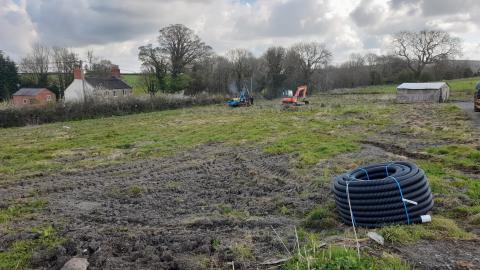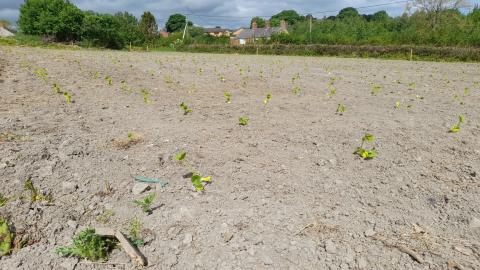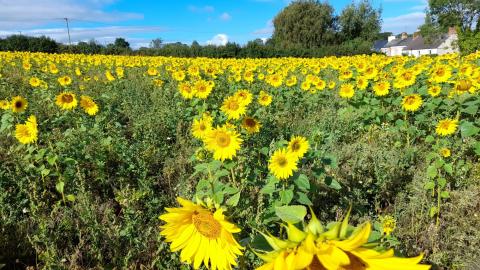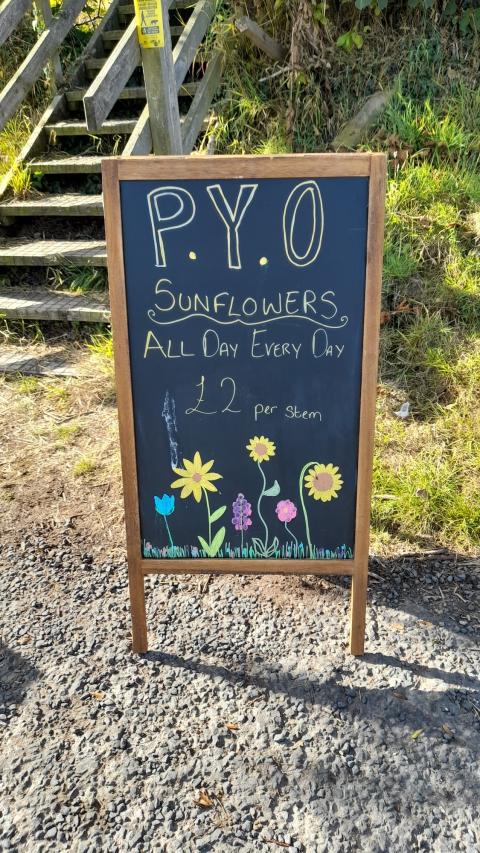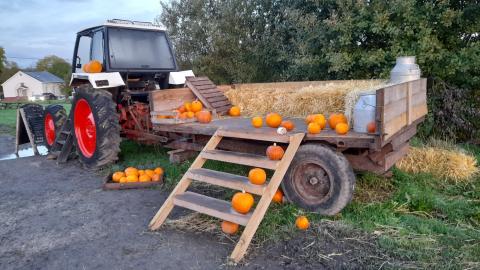Ffrith Farm Final Report: Building a farm destination experience around existing resources
Project title: Building a farm destination experience around existing resources
Introduction
Ed Swan has grown up on the family farm, which is a traditional hill farm in the village of Treuddyn near Mold in north Wales. The Swan family have farmed at Ffrith Farm since 1980 and they produce their own home reared beef and pork to sell from their farm shop on site.
They have approximately 120 beef cattle on the farm, Hereford, Aberdeen Angus, British Blue, Simmental, Charolais, Welsh Black, Limousin, Shorthorn and over 100 Pedigree Welsh pigs, all free range. They have egg-laying hens to keep the shop supplied.
Arable crops of wheat, barley, silage, hay, kale and turnips are grown on the farm to feed the livestock. Harvesting takes place from June to October and supplies them with all the feed needed for the next 12 months.
A Farm Trail allows the public around the circumference of the farm, offering amazing views and opportunities to see the animals grazing in their fields, the farmers at work, the different types of crops grown and some incredible wildlife. It is this area of the farm that the project intended to build on, developing the farm as a destination experience by growing sunflowers and pumpkins, expanding on the visitor offering, bringing in additional income, engaging more with the local community and building biodiversity into routine farm activities.
Pumpkin and flower Pick Your Own(PYO) enterprises have become extremely popular over the last few years, in particular during the Coronavirus pandemic, with people keen to take advantage of local outdoor experiences and activities.
Objectives
The project considered how to make the most of the resources available, using land adjacent to the farm shop not currently in production, and tailored to fit in with the existing labour requirements of the farm. Growing sunflowers and pumpkins requires careful management to achieve production and clearance of the crop to meet the short harvest window; however they can be easily managed alongside current routine farming activities, and in this instance would require limited additional labour and retail input due to having the farm shop on site.
The main aims were to gain knowledge and provide information on:
- Financial viability of all enterprises – farm trail, pumpkins, sunflowers
- Time/labour and cost inputs - number of hours worked, how it impacts and/or compliments existing farming activities, cost of plants, seeds, chemicals, fertilizer, equipment, etc. and income
- Public/community engagement
- Any impacts relating to increased biodiversity
What was done
The site is on the A5104 Chester to Corwen road, next to the existing farm shop and with some parking for customers. The chosen 1ha parcel of land for the pumpkins was clay loam waste ground, waterlogged and overgrown, but within sight of visitors to the farm shop, so an obvious location to develop. The sunflowers were located on a further area of over 1ha behind the shop and planted to the brow of the hill, thus giving the illusion of a full field.
In March 2022 work began on access, with a hard standing road added down to the pumpkin field from the existing shop and parking area. The land was levelled and 500m of land drains were added every 10m to drain the waterlogged areas. Overgrown hedges were cut back together with any scrub encroaching on the field area.
Ffrith Farm drainage work March 2022
The pumpkin area was ploughed and rotovated. A spring tine was used to remove further weeds and consideration was given to using the stale seedbed method to remove stubborn weeds.
Soil sampling was undertaken, and pH and nutrient levels were not concerning so a general 40:20:20 fertilizer was added to maintain nutrient levels.
|
Analysis |
Result |
Guideline |
Interpretation |
|
pH |
7.2 |
6.5 |
Normal |
|
Phosphorus (ppm) |
40 |
71 |
Slightly Low |
|
Potassium (ppm) |
146 |
401 |
Low |
|
Magnesium (ppm) |
68 |
100 |
Slightly Low |
It was decided to use pumpkin plant plugs rather than direct drilling, so a local farm was found to propagate 3,000 Harvest Moon seeds and 1,000 novelty seeds including Kamo Kamo (striped) and Ghost (white).
The sunflower seeds arrived in late March so the new area was cleared ready for planting once the soil got up to 12ºC, to ensure the best germination. 50kg of sunflower seeds were drilled towards the end of May; however, there did appear to be barley and maize in the mix so the hope was that the sunflowers would overpower the cereals.
The propagated pumpkin plants were returned in early May ready for planting. Approximately 3,500-4,000 pumpkin plants of different varieties were planted by hand in mid-May on approximately 0.4ha near to the farm shop. The approach yielded a 90% success rate after planting out. The unusually dry weather however meant that the area needed thorough irrigation to help the new plants bed in. Potassium was added at 200kg per hectare along with 65kg nitrogen, plus a small amount of sulphur, magnesium and calcium to balance soil nutrient levels.
Ffrith Farm pumpkin plans planted May 2022
There was a risk of rabbits damaging the new plants, so an electric fence was installed all around the area. Slug damage was also monitored and the plants treated with organic slug pellets where required.
June was a particularly arid month so the pumpkins were all watered over a week’s duration. At this stage they would not usually need further watering or feeding with nutrient levels having been corrected at planting.
Weed control was critical at this stage of growth, so Chris Creed, ADAS agronomist, advised mechanical weeding over the next 10 days before the weeds overtook the crop. Weeding was done by down row cultivation and in row hoeing. The pumpkin plants had established well but weeds needed to be controlled to prevent competition for nutrients and light. Any spraying was done very carefully to avoid damaging the plants, so cultivation was favoured over spraying.
The sunflower plants were doing well at this stage and were established. A wildflower mix was added to the area to bring colour and biodiversity to the field. Wildflowers also edge the main fields making the farm trail more interesting for customers when they visit later in the year.
July 2022 was an extremely hot, dry month with record breaking high temperatures. This meant extra watering of the pumpkin plants where possible. There was still a large amount of weeds, including fat hen (white goosefoot), which is a fast growing weedy annual. Fat hen extracts considerable quantities of nutrients from the soil therefore needed removing. It also grows high in stature, so can affect the aesthetics of the pumpkin picking area and could block light. Despite the weeds, a large proportion of the pumpkin plants had established and were starting to bear fruit.
At this point, marketing and preparation for welcoming visitors is important, remembering to consider:
- social media
- posters
- contacting local schools
- opening days/times
- parking
- risk assessment of public areas
- making the farm trail safe underfoot
- signage
- seating areas
- toilets
- food & refreshments
- a booking system (if necessary)
- costings for sunflower and pumpkin PYO
There was a slight issue with powdery mildew on the pumpkin leaves in August so they were treated with a fungicide and then given foliar feed to help them recover from the treatment. Density wise, the plants were quite spaced apart, but the general rule is 5,000 plants per acre or 12,500 per hectare.
By September the pumpkin areas were coming on well despite there being a lot of weeds. Harvest Moon is a beginner’s pumpkin so easy to grow and the Mars variety were doing well too. With a wet September, once the pumpkins are ready, it is worth considering picking them and storing in a dry area to avoid rot.
Results
By July the sunflower field was well established, although the flowers were smaller than the year before. The wildflowers were looking colourful with phacelia flower blooming purple, which attracted pollinators and added to the biodiversity on the farm.
Ffrith Farm PYO sunflower field August 2022
By August, the sunflower PYO was in full production and was being promoted on social media, in the shop and on A-boards, using an honesty box to collect payment. The chicken and pig enclosures had also been completed, with the farm trail enabling customers to see the fields, plants and animals and learn more about them through information signs.
Ffrith Farm sunflower PYO signage August 2022
Social media was an integral part of promoting the PYO, with 1,000 new followers brought in. There were approximately 1.2ha of sunflowers and 2,200 flowers were sold at £2 each. Initial seed cost was approximately £100. Once the flowers die back, the seeds can be left as food for the birds, bringing additional biodiversity and wildlife onto the farm. Wildflowers were sown to support the bees and add life to the fields. Sunflowers take two and a half to three months from seed to flower, so if sown early April they will be available from mid June.
The pumpkin areas were open from the 5th October on the days that the shop was open on Thursdays, Fridays and Saturdays plus an extension to include Sundays, with Monday 31st October as the final day . Promotion was done through existing social media platforms. Providing refreshments was considered to provide additional income, but not implemented for this year.
Ffrith Farm mixed pumpkins October 2022
Customers purchased far more pumpkins than expected so coming into the final weekend before Halloween stocks were depleted although there were just enough for customers. The pumpkins grew well and the unusual varieties were the most popular with visitors plus they can command a higher price. Remaining weeds eventually benefitted the areas as they prevented the ground from becoming too muddy underfoot. Wheelbarrows were provided free of change along with entry to all areas of the farm trail. Customers purely paid for the pumpkins they picked and footfall increased in the shop, leading to additional purchases.
The pumpkin PYO ended on the last weekend of October, up to Halloween on 31st October. It was a great success and busy until the last day, with approximately 3,500 pumpkins sold and just around 100 small ones left over which were fed to the pigs, so nothing was wasted.
Straw was put in the high traffic areas so as to avoid it becoming too muddy and customer feedback was positive with comments highlighting how family friendly it felt and not too commercialised. Pumpkins cost from £2 with unusual varieties commanding a slightly higher price and up to £8 each. Sales increased in the shop with the extra footfall and new customers have been secured for the future.
Costs and returns
Infrastructure
The work that took place is being viewed as a long-term investment as the land has been brought back in to use on the farm and is no longer water logged.
The farm trail is open all year round during shop opening hours and has proved a big hit with visitors, particularly families with children.
Prices seeds and plants
Pumpkin seeds and propagation - £700
Sunflower seeds - £100
Potash & fungicide - £600
Wheelbarrows - £200
Labour
Additional labour - £200
Returns
Sunflowers – sold approximately 2,200 for £2 per stem
Pumpkins – sold approximately 3,500 for between £2-£8
Conclusions
Overall, the summer drought meant that both the sunflowers and pumpkins were slower growing and ultimately smaller. Most of the pumpkin growth occurs from August onwards which coincided with the driest weather. There was 100% fertilisation meaning every plant sown bore fruit, no doubt helped by bees from the phacelia nearby.
Customers enjoyed the photo opportunities on the tractor and around the farm trail and this also contributed to the social media engagement over the PYO period. The whole farm attraction worked well in its entirety, with people enjoying interacting with the animals resulting in a positive total on farm experience. The small wheelbarrows were a hit with children and families.
Ffrith Farm photo opportunity area October 2022
Having the farm shop offers an opportunity for payment footfall to go through the shop, meaning no increased retail labour costs. Having a PYO on land next to the shop creates a platform for educating the public on biodiversity, pollinators, carbon footprint and so on, giving them buy in and a feel-good factor for supporting the shop and farm. Ffrith Farm is keen to diversify so as to fill the quiet gaps in the farming year and to also become more sustainable in terms of biodiversity and protecting the business and land for future generations.
Ed Swan, Ffrith Farm October 2022
Learnings
- Parking was an issue and additional parking areas will be needed next year as pumpkin pickers stay longer than the usual shop customer, meaning queues developed and the car park was full constantly
- Clearing up and preparing for the next day needed additional labour after each session
- Essentially the entry fee was included in the price of the pumpkins so it may be worth considering how to promote this fact with future customers
- Encouraging people to enjoy the whole farm experience creates the perception of being much better value for money
- Having the public on site does require you to be sociable at all times!
Last word from Ed “Overall it all felt like a success and it extended our reach to more, and new customers. Next time I will put more pumpkin plants in the same area to reduce the spacing. I planted them at 4,000 plants per hectare whereas they can go in at 5,000 plants per hectare. I intend to keep on top of the weeds too and tackle them earlier next time!”


